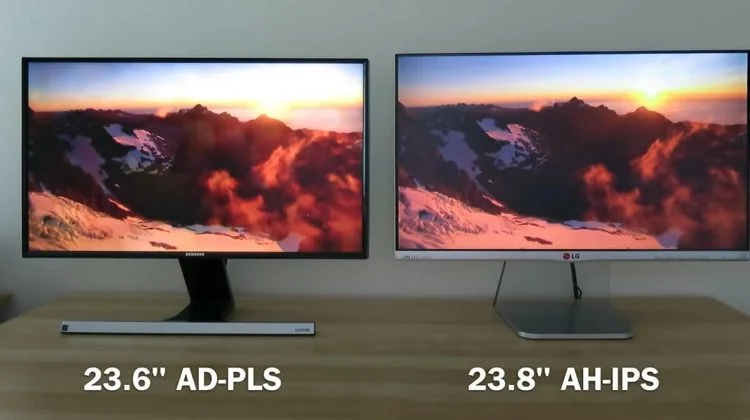What Is a PLS Screen?
PLS (Plane-to-Line Switching) is Samsung’s take on wide-angle TFT LCD technology, offering a powerful alternative to traditional IPS panels.
At its core, a PLS display uses the same horizontal alignment of liquid crystals as IPS—but with patented twists designed to:
- Deliver striking color uniformity, even from off-axis views
- Improve light transmittance, yielding brighter visuals at the same power
- Enhance overall image quality with Samsung’s proprietary refinements
PLS appears most often in Samsung-branded monitors, tablets, and professional-grade devices where consistent color across the screen is essential—even though it’s less widespread than IPS in the broader market.
What Is an IPS Panel?
IPS (In-Plane Switching) is the industry-standard wide-angle LCD technology found across brands like LG, Dell, and Apple. It was originally developed by Hitachi and gained traction for its:
- Ultra-wide viewing angles (up to 178°) with minimal color shift
- High color accuracy and depth suitable for color-critical applications
- Exceptional consistency across entire screen surfaces
This reliability has made IPS the default choice for high-end monitors, medical displays, creative tools, and precision industrial UIs.
PLS vs. IPS: How Do They Compare?
Here’s a side-by-side look at how PLS stacks up against IPS across key metrics:
| Caractéristique | PLS Screen | Panneau IPS |
|---|---|---|
| Angle de vision | Excellent (≈178°) | Excellent (≈178°) |
| Color Uniformity | Very high | Industry benchmark |
| Brightness Efficiency | Slightly higher | Depends on panel grade |
| Contrast & Black Level | Moderate (≈1000:1) | Slightly superior on premium IPS |
| Temps de réponse | ~5–8 ms | ~5–8 ms |
| Cost Efficiency | Often more affordable | Varies with brand and quality |
| Ecosystem & Supply | Samsung-centric | Broad support (LG, AUO, BOE etc.) |
In practice, engineers often see PLS as Samsung’s optimized version of IPS. It delivers comparable or slightly better performance in some areas—especially perceived brightness and price—while staying true to IPS’s visual strengths.
Are PLS Screens Better Than IPS?
Not exactly—but not worse either.
For most users and industrial applications, the differences between PLS and IPS are subtle. However, here are a few practical distinctions worth noting:
- Power or brightness optimization: PLS panels may require less backlight for a given luminance, so they can deliver the same brightness with lower energy.
- Color-critical applications: Premium IPS panels, including variants like AH-IPS or Nano IPS, may still hold an edge for ultra-precise color workflows.
- Supply chain considerations: PLS is Samsung-specific, while IPS offers a broader vendor base—important for long-term procurement.
Where IPS Still Leads
IPS remains the go-to in settings where visual fidelity matters most:
- Professional photo/video editing and color grading
- Medical diagnostic displays
- High-end consumer tablets (e.g., iPads, Surface devices)
- Automotive infotainment systems demanding wide viewing angles
- Industrial user interfaces where consistent quality is key
Due to its broad manufacturer support and myriad panel grades, IPS offers flexibility in feature-rich or regulated applications.
Choosing Between PLS and IPS for Your Display Project
Here’s a practical matrix to help you decide:
| Application | Recommended Panel |
|---|---|
| Interface utilisateur graphique (GUI) générale pour bureau ou industrie | PLS ou IPS |
| Déploiements matériels sensibles au budget | PLS |
| Création de contenu avec précision des couleurs | IPS (qualité premium) |
| Besoins d'affichage haute luminosité ou extérieur | PLS ou IPS haut de gamme |
| Accès large aux fournisseurs d'écrans et compatibilité | IPS |
Votre choix final doit également prendre en compte les dimensions du panneau, la compatibilité des interfaces (RGB, MIPI, LVDS), les objectifs de luminosité, le budget et la disponibilité à long terme.
Foire aux questions
Q1 : Les écrans PLS sont-ils simplement des IPS rebaptisés ?
Pas exactement. Le PLS utilise une physique des cristaux liquides similaire mais inclut des optimisations techniques de Samsung—par exemple, une meilleure transmission lumineuse et une attention accrue à l'uniformité.
Q2 : Les panneaux PLS consomment-ils moins d'énergie ?
Parfois. Grâce à une efficacité optique améliorée, ils peuvent atteindre la luminosité souhaitée en utilisant moins de rétroéclairage avec le même budget énergétique.
Q3 : Puis-je m'attendre à la même reproduction des couleurs avec l'IPS et le PLS ?
Pour la plupart des panneaux milieu de gamme, oui—les différences sont subtiles. Dans les panneaux IPS haut de gamme pour professionnels des couleurs, de légères améliorations en cohérence peuvent être perceptibles.
Q4 : Puis-je remplacer un écran IPS par un panneau PLS sur mon produit ?
Oui—à condition que les dimensions du panneau, les spécifications de synchronisation et les interfaces électriques correspondent. Vous devrez peut-être ajuster le réglage de l'affichage ou le mappage des couleurs.
Q5 : Lequel offre de meilleures performances en extérieur ?
Le PLS peut offrir une meilleure efficacité lumineuse par watt, mais les deux technologies bénéficient significativement d'un collage optique optionnel ou de revêtements anti-reflets.
Réflexions finales
Les deux Le PLS et l'IPS offrent d'excellentes expériences visuelles, de larges gammes de couleurs et de grands angles de vision. Si vous vous procurez des modules d'affichage pour systèmes embarqués—en particulier ceux compatibles Samsung—le PLS peut réduire les coûts et augmenter la luminosité. Si vous avez besoin d'options étendues de fournisseurs et d'une précision avancée en étalonnage des couleurs, l'IPS reste incontournable en flexibilité.
En bref : aucune n'est intrinsèquement meilleure, mais chacune a son domaine de prédilection selon les besoins de votre application.

